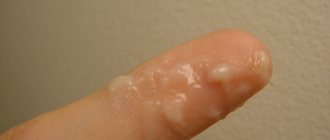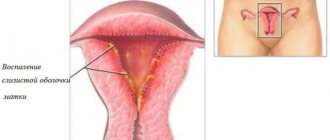What is erosion (ectopia) of the cervix?
Doctors today call cervical erosion ectopia. Ektopos translated from Greek means “displaced.” The displacement of the cell layer, in general, is the essence of erosion. Normally, the cervix is covered by two different layers of epithelium: flat - on the vaginal part of the cervix and cylindrical - in the cervical canal. The columnar epithelium sometimes moves to the vaginal surface of the cervix, taking the place of a flat layer. But “relocation” to this more aggressive environment easily injures the delicate columnar epithelium. As a result, the layer of cells is damaged, and a red, loose area appears at the entrance to the uterus - erosion.
Up
What is erosion?
Suppose that a defect or wound has formed on the neck as a result of injury or inflammation. Usually it exists for a short time, heals quickly on its own, and the gynecologist rarely gets to see it. This is true cervical erosion.
The question automatically arises: what does the doctor see when he announces to a woman the diagnosis: “You have erosion”? When examined in the mirrors, a bright pink rim around the external pharynx is visible. This may be columnar epithelium, since the junction zone has moved to the ectocervix.
This process is called ectopia of columnar epithelium. It can occur under the influence of hormonal disorders, inflammatory changes, and therefore is observed not only in young girls. It is often called pseudoerosion or endocervicosis.
The diagnostic problem is that much more serious diseases visually look exactly the same: a bright pink rim around the external pharynx.
We may be talking about epithelial dysplasia, that is, there is a violation of the number and rowing in the layers of the integumentary cervical epithelium. Dysplasia is divided into degrees depending on the extent of the process and refers to precancerous diseases.
In international medical terminology, the term “dysplasia” (erosion) has been replaced by “intraepithelial neoplasia”.
Causes of cervical erosion
In most newborn girls, under the influence of “mother’s” female hormones-estrogens, cervical ectopia is formed - and this is normal. This type of erosion is called congenital
and, as a rule, they are not treated - ectopia disappears on its own over time.
Another thing is acquired erosion. In this case, the epithelial defect occurs due to sexually transmitted infections, inflammatory diseases of the genitourinary tract, early onset of sexual activity, hormonal disorders and cervical injuries
received during childbirth, abortion and surgical procedures.
Cauterization of erosion
Gone are the days when cervical erosion was treated exclusively by surgery. Surgery in this area has great consequences for a young woman who plans to have children. A damaged or severely injured part of the organ loses its main function - closing the passage to the uterus during pregnancy, which means the woman may lose the child.
Statistics show that a lot of miscarriages, both in early and late stages of pregnancy, occur due to mechanical damage or operations on the woman’s internal genital organs in the past.
That is why new methods of cervical erosion have been invented, namely cauterization. There are several methods in total. The tumor can be cauterized with a laser, electric current, or liquid nitrogen. Depending on how extensive the damage to the mucous membrane is and at what stage the disease is, the doctor chooses the most appropriate method of treatment.
Coagulation with laser beams
A modern treatment method that will get rid of erosion once and for all. Side effects of this cauterization method include the formation of burn scars and long healing of the affected area. However, laser cauterization of erosion is the most famous and common method of treatment; it is prescribed to many patients.
Cryodestruction - cauterization of the cervix with nitrogen
Erosion on the affected area is removed by freezing. Liquid nitrogen is used for this. Cryodestruction is the most preferred method of treating cervical erosion: it is painless, has no contraindications, and soft, invisible scars form after it.
Diathermocoagulation
Therapy using electric current. However, like any other thermal method of exposure, it leaves extensive burns and scars.
Chemical coagulation
This method of treatment involves treating the affected area of the mucosa with special solutions that destroy damaged cells. It is used in the early stages of cervical ulceration, and if there is no degeneration into malignant cancer.
Surgery
Surgical removal of the cervix (or part of it) in case of early stage cancer.
Ectopia - is it dangerous?
On this issue, medical opinions are divided. Some experts consider ectopia to be a normal phenomenon that requires observation rather than treatment. Others remind: erosion is a good background for the development of cervical cancer
, because the main culprits of this cancer, oncogenic types of human papillomavirus, easily and deeply penetrate into the damaged surface of the cervix. Considering that every second person who is sexually active is infected with different types of HPV, the alarm is not unfounded. In addition to HPV, ectopia easily “allows in” other infections: herpes virus, mycoplasma, chlamydia, ureaplasma, etc.
Cervical erosion: treatment
Before treating ectopia, you need to figure out why it occurred. To do this, in addition to the tests already mentioned, you will have to take PCR swabs
for trichomonas, HPV, herpes virus, gardenerella, urea and mycoplasma, chlamydia, make
a smear “for flora”
and
bacteriological culture of the vaginal microflora
.
Plus take blood tests
for HIV, syphilis, hepatitis B and C and check if everything is okay with your hormones. If the cause of erosion is a hormonal imbalance or genital infections, treatment may be limited to drug therapy and local remedies. When conservative measures are not enough (or the ectopia reappears after treatment), surgical treatment methods are used.
Cauterization of cervical erosion: how and with what?
They do everything they can with erosion: they “freeze it out” with liquid nitrogen, evaporate it with a radio wave, destroy it with a laser, burn it with electric current... And all so that in place of the destroyed cylindrical epithelium, flat epithelium “grows” again. So, what methods will help with this?
Cauterization of erosion with preparations containing organic acidsChemical coagulation - cauterization of cervical erosion with preparations with organic acids. During coagulation, a scab appears at the site of erosion, and new epithelial cells appear underneath it. After a few days, the scab peels off, but the cervical epithelium will completely recover in about 6 weeks. pros : acids do not damage the deep layers of tissue, do not leave scars on the uterus, maintaining its elasticity - a necessary condition for a successful birth. The method is well suited for nulliparous women. Minuses : Chemical coagulation is not suitable for the treatment of deep erosions. |
Cryodestruction - “freezing out” erosion with liquid nitrogenPros: the procedure is painless and is carried out free of charge in the antenatal clinic under the compulsory medical insurance policy. Minuses: long recovery. Their healing area may “ooze” lymph for a whole month, and this means discharge and an unpleasant odor. In addition, after cryodestruction, relapses of ectopia are common. |
Laser coagulation – removal of ectopia with a laser beampros : using a laser it is easy to change the depth of exposure, so the method is well suited for removing both superficial and deep erosions. Laser coagulation is painless and safe for nulliparous patients. After treatment, there are no stenoses or scars left, and healing is faster compared to other methods. Minus : Laser coagulation is an expensive procedure. |
Radio wave methodRadio wave surgery – removal of ectopia with a narrowly directed beam of radio waves. Radio waves “evaporate” water from the damaged layer of cells and destroy it. Pros: The method is well suited for nulliparous women. After the procedure, no scab or scar is formed, healing proceeds quickly. Minuses: Like laser coagulation, radio wave surgery is available mainly in private clinics and is not cheap. |
Treatment of erosion using an argon plasma torchArgon plasma coagulation is the treatment of erosion with the energy of an electromagnetic field using an argon plasma torch. The procedure is non-contact: an active electrode is applied to the site of ectopia, then a torch of argon plasma is “launched” and the affected areas on the cervix are removed with it. Pros: rapid healing and absence of scars on the cervix after treatment. Minuses : high cost of the procedure. |
Cauterization of erosion with electric currentDiathermoelectrocoagulation – cauterization of erosion with electric current. Minuses : an outdated and very traumatic method. When removing ectopia with electric current, the deep layers of uterine tissue are damaged, scars remain, and there is a risk of bleeding and stenosis of the cervical canal. Diathermoelectrocoagulation is not performed on nulliparous women. |
Ectopic cervix during pregnancyGynecologists do not recommend surgical treatment of erosion during pregnancy: the cervix will “open” worse during childbirth. In addition, ectopia, as a rule, does not affect the course of pregnancy. |
Up
Gentle treatment methods
Treatment of cervical erosion in nulliparous women and girls is carried out only with gentle methods, after which scars and adhesions do not form. Today there are several such methods. Which one to use is decided only by the doctor individually for each patient.
- Drug treatment. This method is appropriate for untreated erosion accompanied by inflammatory processes. This treatment is carried out immediately for both sexual partners. In this case, during treatment you should avoid sexual intercourse or be sure to use a condom.
- Cryodestruction or freezing. Treatment involves applying liquid nitrogen to the affected area. As a result, damaged cells freeze and die. In this case, healthy cells are not affected. The procedure is painless and does not cause bleeding after it is performed. There are no scars left on the cervix and it is not deformed.
- Laser therapy. The essence of the method is the direct impact of a laser beam on the affected tissue. The laser beam penetrates to the required depth and destroys the affected cells without affecting adjacent healthy tissue. The vessels are immediately welded, so rapid healing occurs, and no traces remain at the wound site. The method is highly effective and safe.
- Cauterization by radio waves. It is carried out using the Surgitron apparatus. The procedure is painless, but you may experience some bleeding for several days afterwards. You should abstain from sex for 2-3 weeks. And after 4-5 weeks, visit a gynecologist for a follow-up examination.
- Cauterization with drugs. Impact on the affected areas and destruction of diseased cells is possible with the help of drugs such as Solkovagin and Vagotil. The first drug allows you to cope with erosion in one procedure. In the second case, several procedures may be required.
Each method is aimed at destroying the affected cells, however, unlike electrocoagulation, the above methods do not entail undesirable consequences for women who are yet to become pregnant and give birth. Often, minor erosion at the initial stage is only observed by a gynecologist before treatment is prescribed.
It should be remembered that there are no universal methods for treating erosion, especially in nulliparous women. Only a doctor can assess her character and prescribe the most appropriate treatment with minimal consequences for the patient.
In any case, you cannot ignore the condition of the cervix without attention and let the disease take its course. Over time, it progresses and can lead to unwanted dangerous consequences. Therefore, you should regularly visit your gynecologist for a routine examination, even if nothing bothers you.








